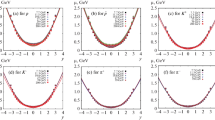Abstract
A new method is developed for determining the mass of particles coming to rest in nuclear emulsions. Multiple coulomb scattering is measured with cells whose lengths vary along the trajectory in such a manner as to compensate for the momentum loss of the particle and keep the mean deviation between adjacent cells constant over the entire track. It is shown that this procedure is more convenient and inherently more accurate than that based on scattering measurements with constant cellsize. The method has been applied toK-mesons which at the end of their range either decay into a single charged relativistic particle (K +-mesons) or into 3π-mesons (τ-mesons) or give rise to capture stars (K −-mesons). The results are within experimental error consistent with the assumption that the mass of these three classes of particles are identical and equal to the well established mass of theτ-mesons. The average mass of a group of 9 longK-mesons determined with our scattering procedure is M K =974±42m e .
Similar content being viewed by others
References
Kayes, G. and Morellet, D...J. Physique Rad., 1953,14, 353.
Van Rossum, L...Comptes Rendus, 1953,236, 2234.
Ritson, D. M. .. “SomeK-particle Mass Measurements.” To be published inPhys. Rev.
Menon, M.G.K. and Rochat, O...Phil. Mag., 1951,42, 1232.
Fowler, P. H... Ibid., 1950,41, 169.
Beiser, A...Rev. Mod. Phys., 1952,24, 282.
Smith, J. H...Phys. Rev., 1947,71, 32.
Willams, E. J...Proc. Roy. Soc., London, 1939,A 169, 531 andPhys. Rev., 1940,58, 292.
Voyvodic, L. and Pickup, E...Phys. Rev., 1952,85, 91.
Lal, D. Yash Pal and Peters, B.Proc. Ind. Acad. Sci., 1953,38 A, 277.
Kendall, M. G...The Advanced Theory of Statistics, Vol. I (Charles Griffin and Co., Ltd.), 1945, p. 215.
Brown, R. H., Camerini, U. Fowler, P. H., Heitler, H., King, D. T. and Powell, C. F.Phil. Mag., 1949,40, 862.
Amaldi, E., Baroni, G., Castagnoli, C., Cortini, G. and Manfredini, A.Nuovo Cimo, 1953,10, 937.
Lal, D., Yash Pal and Peters, B.Proc. Ind. Acad. Sci., 1953,38A, 398.
Author information
Authors and Affiliations
Additional information
Communicated by Prof. H. J. Bhabha,f.r.s., f.a.sc.
Rights and permissions
About this article
Cite this article
Biswas, S., George, E.C. & Peters, B. An improved method for determining the mass of particles from scatteringversus range and its application to the mass ofK-mesons. Proc. Indian Acad. Sci. (Math. Sci.) 38, 418–439 (1953). https://doi.org/10.1007/BF03045250
Received:
Issue Date:
DOI: https://doi.org/10.1007/BF03045250



